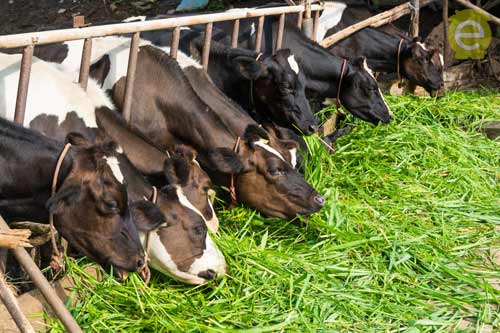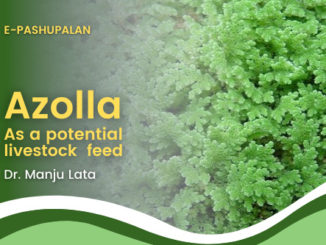Abstract
India is celebrated nutrition week this September month. All we have a great focus on our human health, but why we can’t focused on our pashudhan. Good health is essential for good performance and the welfare of dairy cows, and nutrition an important component of good health. Health is influenced by the interaction between the innate adaptive components of the immune system and other factors, such as the local and systemic inflammatory response, which can sometimes be more harmful than useful. Therefore, for dairy cows, particularly those in the pre-parturient period, it is important to avoid, or reduce as much as possible, any kind of infectious, parasitic or metabolic disease and the associated inflammation. Such inflammation can impair cow performance by lowering milk yield, dry matter intake, fertility and energy efficiency, and can reduce liver function. Good nutrition is essential in maintaining a functional immune system, while also avoiding other causes of inflammation, such as tissue damage, and digestive and metabolic syndrome-related disorders. Provision of appropriate nutrients, such as antioxidants, omega-3 polyunsaturated fatty acids, conjugated linoleic acid and vitamin D can have anti-inflammatory effects. In the future, ways to reduce inflammation while maintaining a good immune defence must be developed and the susceptibility of the cow to diseases and inflammation evaluated. Ideally, we would be able to selectively breed for cows with a lower susceptibility to both diseases and inflammation. Along with the dairy forms herd we should focused on small rearing livestock animals and their health because they are also a source of income to marginal farmers.
Introduction
In a conventional sense Animal Nutrition is the science of feed preparation and feeding i.e. how feeds should be prepared and fed to animals to produce adequate and safe food and non-food materials such as wool or manure. Availability, in a sustained manner, of desired type and quantity of animal feed and its feeding is the foundation of livestock production system. Animal feed availability and animal feeding is a multi-faceted theme. It influences all livestock sub-sectors across production systems. It also has far reaching effects on human nutrition, poverty, food prices and global economy. It impacts almost every sector of the livestock production– from animal reproduction, health and welfare– to farm economic viability, environment, animal product safety and quality.

ANIMAL NUTRITION AND PRODUCTIVITY
Poor feeding decreases productivity of the animal. A vast array of survey on nutrition-reproduction interactions shows that good feeding increases milk production of lactating animals. It also increases growth rate of meat producing animals, giving more meat. Good nutrition increases reproductive efficiency: higher cyclicity, lower age at first calving, lower inter-calving interval, higher productive life and higher profitability to farmers. Furthermore, now a good body of evidence exists showing that in utero nutrition has impact on productivity and health of offspring’s later in life.
Animal Nutrition and farm economic
Feed is financially the single most important element of animal production, irrespective of species and production system. Feed cost can account for up to 70% of the total cost of production of an animal product. High feed costs can wipe out a livestock rearing operation. In, high cost of feeds decreased supply of animal products and increased prices. Optimization of feed use efficiency i.e. producing more with less feed decreases feeding costs and increases economic viability of the livestock operation.
Animal nutrition and product safety and quality
The safety and quality of the food chain can be affected because of the close link between feed and food-borne pathogens such as Escherichia coli, Salmonella and Campylobacter. These pathogens can get into animal products through animal feed. Mycotoxins, heavy metal, radionuclides, pesticides, dioxin, dibenzofurans, and other toxins present in feed get transferred into animal products affecting animal and human health and product safety. Animal feed safety impacts on animal health, welfare and productivity as well as safety of the human food supply and the livelihood of farmers. Microbial species such as Salmonella enterica that are pathogenic for humans are also found in fresh food plants Further, survival of these pathogenic bacteria in soil was also found to be affected by how manure is managed and the composition of the diet fed to cattle that produced the manure Safe feed helps to reduce production costs, maintains or increases food quality and reduces feed and food losses and wastes. Contaminated feed has often resulted in food of animal origin being recalled and/or destroyed with significant economic losses for the livestock industries and a negative impact on food security. Feed is an integral part of the food chain, feed production must therefore be subject, in a similar manner as food production, to the quality assurance of integrated food safety systems.
Animal nutrition and environment
The livestock production is resource demanding: it occupies 30% of the world’s ice-free surface and consumes 8% of global human water use, mainly for the irrigation of feed crops. The area dedicated to feed-crop production represents 33% of total arable land. In addition, animal products generally have a much higher water and carbon footprints than plant-based foods and livestock sector contributes approximately 14.5% of all anthropogenic greenhouse gas (GHG) emissions (7.1 Gigatonnes of CO2-equivalent per year). Globally, the production, processing and transport of feed account for about 45% of the GHG emission from livestock sector. At a species level, feed production constitutes 47% and 57% of emissions from pork and chicken supply chains, respectively. For cattle, small ruminants and buffalo, feed production contributes 36%, 36% and 28% of the total emissions respectively (Gerber et al., 2013). Feed nutrients (70 to 90% of nitrogen and phosphorus) are lost into the environment through manure, which if not managed properly can lead to environmental pollution. Livestock contribute 37% of anthropogenic CH4, mostly from enteric CH4, which is largely feed dependent. Feed production and use also impact land use and land use change, which also leads to loss of sequestered carbon and biodiversity. Both environment and biodiversity degradation have linkage with ecosystem and human health. Smart feeding practices, especially the balanced ration approach i.e. feeding a diet containing nutrients such as protein, carbohydrates and minerals in the right proportion and in an amount that meets the nutrient requirements of animals for achieving the targeted production would decrease nitrogen, phosphorus and methane release in the environment and the biodiversity loss. Use of locally adapted feed resources is also expected to conserve biodiversity.
Animal nutrition and food–feed competition
In previous years, million tonnes of cereals (one-third of total cereal production) were used in animal feed and by 2050 an additional 520 million tonnes would be required for feeding livestock. In 2000, 78% of feed grains were fed to pigs and poultry in regions where industrial intensive system dominate. In the last 20 years, there has been an increased interest in forage-fed beef for multiple reasons (health related, environmental concerns, and welfare issues). Use of smart feeding options such as decrease in the level of grains in the concentrate by using agro-industrial by-products, increase in green fodder use, feeding of total mixed ration instead of feeding individual ingredients, use of chopped forages, increase in digestibility of crop residues could contribute to decrease in grain in diet.
Animal nutrition and feed–fuel competition
About 10% of global production of course grains are used for bioethanol production. A continued rapid expansion of biofuel production up to 2050 would lead to the number of undernourished pre-calves and lambs. Efficient use of alternate novel feed resources such as biofuel coproducts e.g. glycerol, dried distillers grains, gluten meal, cassava residue, Camelina sativa meal, sweet sorghum residue, kernel meal from the non-toxic Jatropha, pongamia meal, castor meal, palm kernel meal, and algae residue would contribute to decreasing feed-fuel competition.
Animal nutrition and animal health
Improper nutrition (unbalanced diet, under or over feeding) impacts health adversely directly, and also makes animals more prone to diseases. Furthermore, in case of disease, corrective measures in the form of medicines are less or not effective. Vaccination done during the period of improper nutrition might also properly protect the animals. Correct nutrition can reduce infectious afflictions by enhancing cell-tissue integrity and optimizing defence mechanisms of the immune system. Feeding of balanced ration has been shown to increase immuno-globulin levels in blood, suggesting higher immunity. Supplements such as minerals, antioxidants and amino acids such as methionine also play a role in immune stimulation. Good nutrition is also a biosecurity measure to control zoonotic and infectious diseases
Animal nutrition and animal welfare
Feeding to sustain high production levels, nutrient deficiency or excess can lead to metabolic disorders in ruminants such as acidosis and lameness causing welfare issues; whilst breeding animals of monogastric species which are restrict-fed to optimise health and production may suffer from chronic hunger. A number of welfare problems in ruminants are elicited by the feeding of poor quality or unsafe feeds. A properly balanced diet free of undesirable substances and water supplied in adequate amounts avoid physical and psychological suffering from hunger and thirst; furthermore correct nutrition is crucial for optimal performance and to sustain optimal fitness.
Animal nutrition and global security
Increased food-feed-fuel competition can lead to food shortages, high food price and high volatility in prices. This could adversely impact global food security and could possibly trigger civil unrest and conflict among masses and between people and government. Government stability and governance could be affected, resulting on global insecurity. This has happened in the recent past in some developing counties. Animal nutritionists have a role as a peacemaker also by playing with the feeds and feeding in a manner that there is least food-feed-fuel competition and the feed efficiency is optimized to achieve more animal products from less feed.
Conclusive overview of animal nutrition: beyond the boundaries of feed and feeding
Meeting livestock nutritional requirements is extremely important in maintaining acceptable performance of neonatal, growing, finishing and breeding animals. From a practical standpoint, an optimal nutritional program should ensure adequate intakes of amino acids (both traditionally classified essential and nonessential), carbohydrates, fatty acids, minerals, and vitamins by animals through a supplementation program that corrects deficiencies in basal diets (e.g., corn- and soybean meal-based diets for swine; milk replacers for calves and lambs; and available forage for ruminants). Additionally, dietary supplementation with certain nutrients (e.g., arginine, glutamine, zinc, and conjugated linoleic acid) can regulate gene expression and key metabolic pathways to improve fertility, pregnancy outcome, immune function, neonatal survival and growth, feed efficiency, meat quality. Overall, the proper balance of protein, energy, vitamins and all nutritionally important minerals in diets is needed to make a successful nutrition program that is both productive and economical. Both fundamental and applied research are required to meet this goal.
Animal Nutrition
water need
Also crucial to the nutrition program for animals is water. Livestock may have health problems resulting from substandard quality water. Consuming water is more important than consuming food. A successful livestock enterprise requires a good water supply, in terms both of quantity and quality. Safe supplies of water are absolutely essential for livestock. If livestock do not drink enough safe water every day, intake of feed (roughages and concentrates) will drop, production will fall and the livestock producer will lose money.
Condition of animal nutrition
Today’s society, one can’t turn on the TV or read a newspaper without seeing or reading information about health issues. What is the major factor discussed in these issues? Nutrition. Along with nutrition, genetics and environment are all factors influenced the nutrition just like in, human these same factors. If animals don’t have proper nutrition, their growth rate, reproduction rate, immunity, and well-being are all affected. Just as proper nutrition is vital for your good health and proper function, it is just as vital for the health and function of agricultural animals. Importance of Nutrition and Digestion Nutrition is important for a variety of reasons. Animals need the proper nutrition for growth and maintenance, and to provide energy for work and vital functions. Maintenance is the nutrition required for an animal to maintain its current weight. Energy is the ability of the body to perform functions. Proper nutrition is also needed to maintain body temperature, produce milk, reproduce, and develop proper bone structures. Without proper nutrition, animals can develop health problems, which could result in treatment costs or even fatality. Good nutrition is essential for all of the systems of an animal to function and work together properly. Animals that do not receive the proper nutrition are more likely to develop health and reproductive problems, and be less productive and marketable.
Consequence of disease on host nutrition
Role of nutrition in disease management and recovery most diseases and disease conditions can be affected by diet. For some conditions and diseases this may simply be related to the adverse effects of inadequate caloric intake associated with hyporexia or anorexia of illness. For many other conditions and diseases, there are specific nutritional management interventions. Feeding of diseased animals should be based on their nutritional requirements while giving due importance to their natural diet and feeding behaviour. Further, adequate consideration should also be given to the frequency of feeding. Disease-affected animals often have a decreased appetite and weight loss; hence palatability is one of the most important factors deciding the effectiveness of the diet. The quality of the ingredients chosen is also of immense importance. Highly digestible ingredients compensate for the decreased activity of intestinal enzymes, ensuring an optimal nutrient supp. Nutrition is important to have healthy animals, Producers must understand not only what nutrition an animal needs but also how to supply that needed nutrition. Producers must know. A ration is the feed an animal receives over a 24-hour period. A variety of feedstuffs, or basic ingredients, are used in rations, and producers must choose those that best suit their needs. A ration with all the nutrients an animal needs is a balanced ration. Nutrition is important for the health and productivity of agricultural animals. Providing proper nutrition is much more than purchasing a bag of feed or putting animals on pasture. The producer should be knowledgeable about the basics of animal. Each of these systems plays a vital role in animal health. Nutrients are important to animals so all systems function properly. Animals need varying nutrients according to factors such as age, pregnancy, and use. The six major classes of nutrients include water, protein, carbohydrates, fats, minerals, and vitamins. Nutrient deficiencies can cause health problems in animals, leading to death. In addition, an excess of nutrients, such as minerals, can also cause health problems. Feed additives are used to improve performance in an area and are generally not considered a nutrient source. The major types of feed additives are growth regulators and antibiotic.
Conclusion
In general, illnesses in livestock are usually associated with reduced appetite and decreased feed consumption. The effect of infections and other illnesses on the nutritional status of an animal depends on the type and severity of the illness, initial nutritional status of the animal, and more importantly, the feed intake during illness. Accordingly, appropriate nutrition is vital to early restoration of normal health of a diseased animal. More importantly, from the production animal point of view it is one of the key health approaches for increasing/make well the loss in the productivity. While the concept is well established in pet animal practice, its application in large animal practice is still not widely adopted. However, with the changed perspective of livestock production with a focus on feed-food safety and animal welfare, the concept of specialized nutrition of diseased animals could find its place in farm animal practice in the time to come. In the changing scenarios– achieving high production is not only sufficient – high animal productivity, animal product safety and quality, animal welfare and health and protection of environment and biodiversity are also being increasingly demanded. Increasing awareness and emphasis on animal welfare, environment, product safety and quality have become a priority in food production systems involving animals. In this changing landscape animal nutritionists should consider themselves fortunate because they could influence most of the activities of the livestock Sector. Animal nutritionists are at the cross-roads where almost all sectors and services of the livestock industry meet. They are in the driver’s seat for taking the livestock sector towards sustained development following the principles of the Sustainable Animal Diet. Substantial contribution can be made by animal nutritionists in: producing adequate, safe and nutritious food in a humane way in the face of rapid population growth; saving the environment, biodiversity and the way of life of pastoralists and ranchers; bringing smallholder livestock farmers out of poverty; promoting industrial growth, alleviating malnutrition especially in pregnant ladies and growing children that is related to inadequate vitamins, minerals and amino acids consumption; safeguarding public goods including human health; and promoting global security.






Be the first to comment